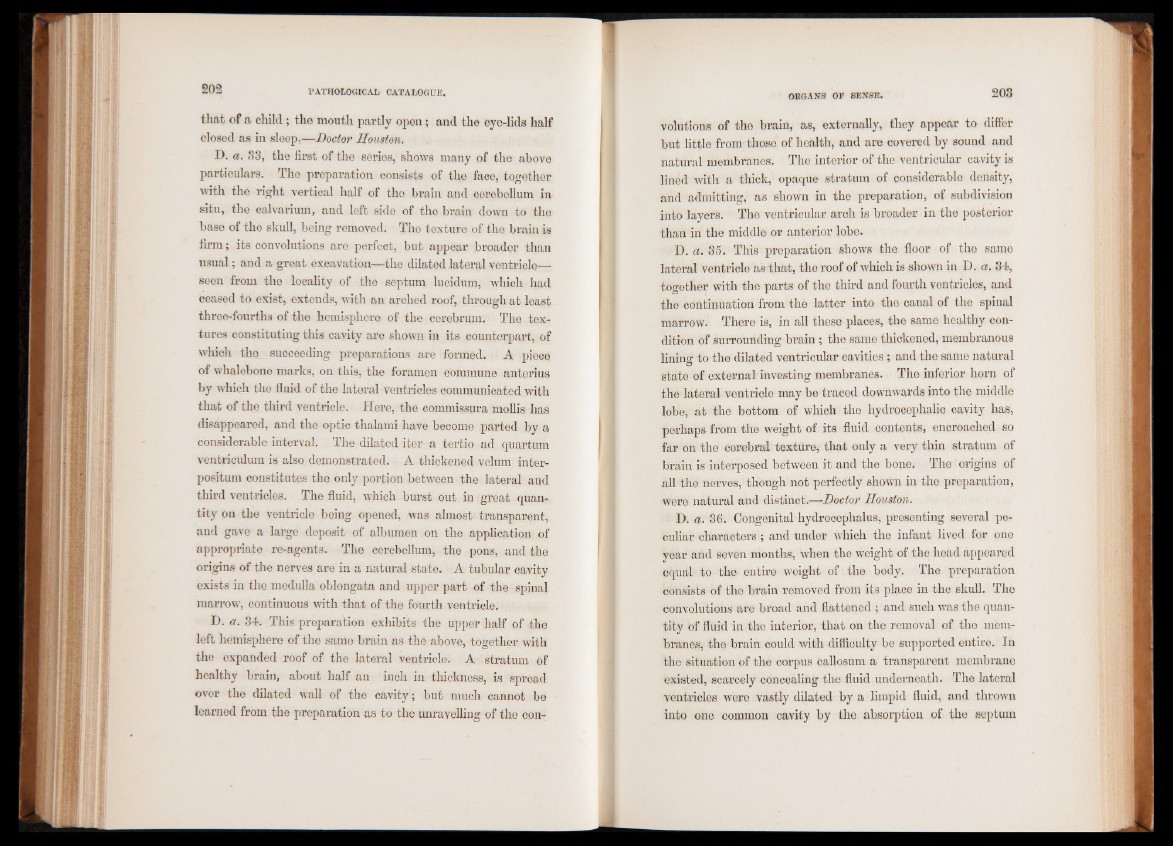
that of a child ; the mouth partly open; and the eye-lids half
closed as in sleep.—Doctor Houston.
D. a. 33, the first of the series, shows many of the above
particulars. The preparation consists of the face, together
with the right vertical half of the brain and cerebellum in
situ, the calvarium, and left side of the brain down to the
base of the skull, being removed. The texture of the brain is
firm; its convolutions are perfect, but appear broader than
usual; and a great excavation—the dilated lateral ventricle—•
seen from the locality of the septum lucidum, which had
ceased to exist, extends, with an arched roof, through at least
three-fourths of the hemisphere of the cerebrum. The textures
constituting this cavity are shown in its counterpart, of
which the succeeding preparations are formed. A piece
of whalebone marks, on this, the foramen commune anterius
by which the fluid of the lateral ventricles communicated with
that of the third ventricle. Here, the commissura mollis has
disappeared, and the optic thalami have become parted by a
considerable interval. The dilated iter a tertio ad quartum
ventriculum is also demonstrated. A thickened velum inter-
positum constitutes the only portion between the lateral and
third ventricles. The fluid, which burst out in great quantity
on the ventricle being opened, was almost transparent,
and gave a large deposit of albumen on the application of
appropriate re-agents. The cerebellum, the pons, and the
origins of the nerves are in a natural state. A tubular cavity
exists in the medulla oblongata and upper part of the spinal
marrow, continuous with that of the fourth ventricle.
D. a. 34. This preparation exhibits the upper half of the
left hemisphere of the same brain as the above, together with
the expanded roof of the lateral ventricle. A stratum of
healthy brain, about half an inch in thickness, is spread
over the dilated wall of the cavity; but much cannot be
learned from the preparation as to the unravelling of the convolutions
of the brain, as, externally, they appear to differ
but little from those of health, and are covered by sound and
natural membranes. The interior of the ventricular cavity is
lined with a thick, opaque stratum of considerable density,
and admitting, as shown in the preparation, of subdivision
into layers. The ventricular arch is broader in the posterior
than in the middle or anterior lobe.
D. a. 35. This preparation shows the floor of the same
lateral ventricle as that, the roof of which is shown in P. a. 34,
together with the parts of the third and fourth ventricles, and
the continuation from the latter into the canal of the spinal
marrow. There is, in all these places, the same healthy condition
of surrounding brain ; the same thickened, membranous
lining to the dilated ventricular cavities ; and the same natural
state of external investing membranes. The inferior horn of
the lateral ventriole may be traced downwards into the middle
lobe, at the bottom of which the hydrocephalic cavity has,
perhaps from the weight of its fluid contents, encroached so
far on the cerebral tcxturo, that only a very thin stratum of
brain is interposed between it and the bone. The origins of
all the nerves, though not perfectly shown in the preparation,
were natural and distinct.—Doctor Houston.
D. a. 36. Congenital hydrocephalus, presenting several peculiar
characters ; and under which the infant lived for one
year and seven months, when the weight of the head appeared
equal to the entire weight of the body. The preparation
consists of the brain removed from its place in the skull. The
convolutions are broad and flattened ; and such was the quantity
of fluid in the interior, that on the removal of the membranes,
the brain could with difficulty be supported entire. In
the situation of the corpus callosum a transparent membrane
existed, scarcely concealing the fluid underneath. The lateral
ventricles were vastly dilated by a limpid fluid, and thrown
into one common cavity by the absorption of the septum